Air of Authority - A History of RAF Organisation
No 431 - 443 Squadron Histories
Squadrons numbered in the 400 series were technically units of the RCAF, RAAF and RNZAF, but their members were placed under the operational control of the RAF and are usually considered to be part of the RAF's organisational structure, hence their inclusion here. Squadron Badges on this page - courtesy of 'Wing for Freedom'
|
|
Formed at Burn on 11 November 1942 as a bomber unit within No 4 Group but in July 1943 it was transferred to the recently created No 6 (RCAF) Group. At the same time it moved to Tholthorpe near York and in December to Croft in County Durham, where it remained until the end of the war. Equipped with Wellingtons initially, it received Halifax Vs when it moved to Tholthorpe and these were replaced by Mk IIIs in March 1944. Its first operation was flown on the night of 5/6 March 1943, a mining operation to the Frisian Islands. In October 1944, it converted to Canadian built Lancaster Xs and it was with this type that it carried out its last bombing mission on 25 April 1945 against gun emplacements on Wangerooge. It returned to Canada in June 1945 and disbanded on 5 September 1945 Motto: The hatitan ronterios (Warriors of the air) |
| Battle Honours |
| English Channel and North Sea 1943-1944, Baltic 1943-1944, Fortress Europe 1943-1944, Rhine, France and Germany 1944-1945, Biscay Ports 1943-1944, Ruhr 1943-1945, Berlin 1943-1944, German Ports 1943-1945, Normandy 1944, Biscay 1943-1944 |
Squadron Codes used: -
| SE | Nov 1942 - Sep 1945 |
431 Sqn photos below courtesy of Bruce Hurley:-
[Aircraft & Markings | Commanding Officers]
No 431 Squadron Association: - email kblazer@eagle.ca
|
|
Formed at Skipton on Swale on 1 May 1943 as a bomber unit within No 6 (RCAF) Group, the first to be formed by the group, previous units having been transferred from No 4 Group. Initially equipped with Wellington, it carried out its first operation on 23/24 May 1943 when it took part in a raid on Dortmund. In October 1943 it re-equipped with Lancaster IIs, the Hercules powered version of this aircraft, and in February 1944 Halifax IIIs. In September 1943, the squadron moved to East Moor, from where it flew its last bombing mission on 25 April 1945 against the island of Wangerooge, disbanding there on 15 May. Motto: Saeviter ad lucem (Ferociously towards the light) |
| Battle Honours |
| English Channel and North Sea 1943, Fortress Europe 1944-1945, France and Germany 1944-1945, Biscay Ports 1944, Ruhr 1943-1945, Berlin 1943-1944, German Ports 1943-1945, Normandy 1944, Rhine, Biscay 1943 |
Squadron Codes used: -
| QO | May 1943 - May 1945 |
[Aircraft & Markings | Commanding Officers]
|
|
Formed at Skipton on Swale on 25 September 1943 as a bomber unit within No 6 (RCAF) Group, the last Canadian bomber unit to be formed in Britain. It operated Halifax IIIs from the start, although these did not begin to arrive until November and it was January 1944 before the squadron carried its first operation, a mine-laying mission to the Frisian Islands. In January 1945 the squadron converted to Lancasters and these were used until the end of the war, its last bombing operation being against Wangerooge on 25 April 1945. Along with other units it then began the repatriation of POWs from the continent and in August was transferred to No 1 Group, in order to continue this work. It then joined Operation Dodge, the repatriation of troops from Italy until disbanding at Skipton on Swale on 15 October 1945. Motto: Quis'y frotte s'y pique (Who opposes it gets hurt) |
| Battle Honours |
| English Channel and North Sea 1944-1945, Baltic 1944-1945, Fortress Europe 1944, France and Germany 1944-1945, Biscay Ports 1944, Ruhr 1944-1945, Berlin 1944, German Ports 1944-1945, Normandy 1944, Rhine Biscay 1944 |
Squadron Codes used: -
| BM | Sep 1943 - Oct 1945 |
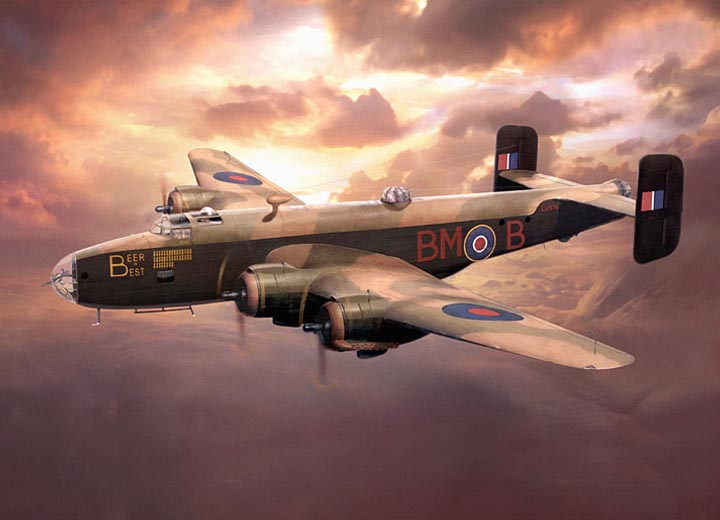 |
| Halifax III, LV967 'Beer is Best' - No 433 Sqn |
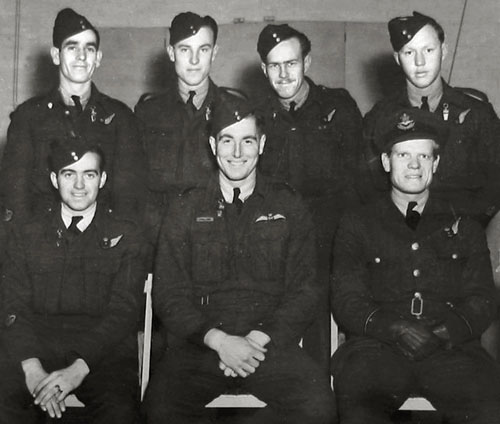 |
|
The group photograph was taken at RAF Leeming when the crew were presented to the King and Queen in 1944. Back row left to right. Harold Edwards ( Eddy ), Terry Hobbs, Vic Swimmings, and Rolland Wallice ( Wally ). Front row. Ernie Dickson, Charles Appleton ( Chuck ), and Murray Dobson. |
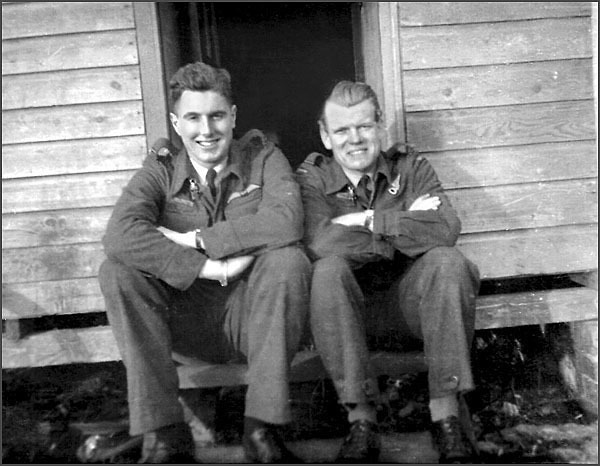 |
| Charles Appleton and Murray Dobson |
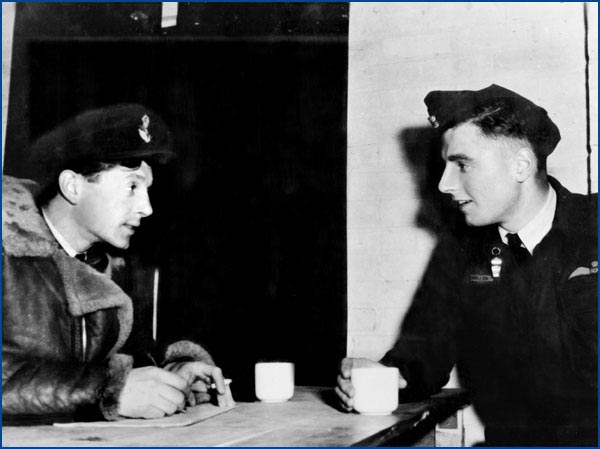 |
|
Clive Stinton with Charles Appleton during a post raid debriefing. |
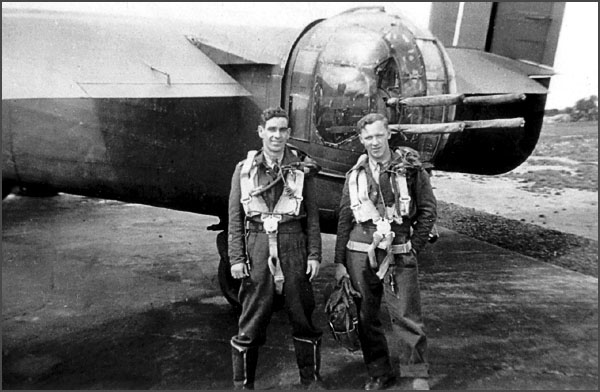 |
|
Harold Edwards and Rolland Wallace by the rear turret of BM-B 'Beer Is Best'. |
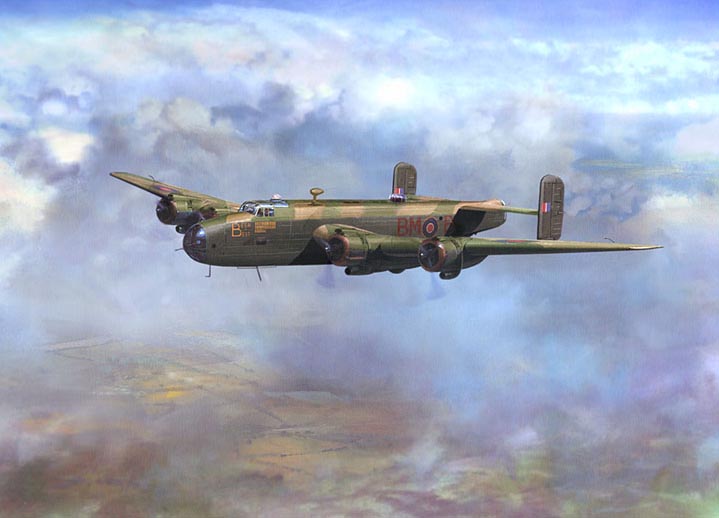 |
| Halifax III, LV967 'Beer is Best' - No 433 Sqn |
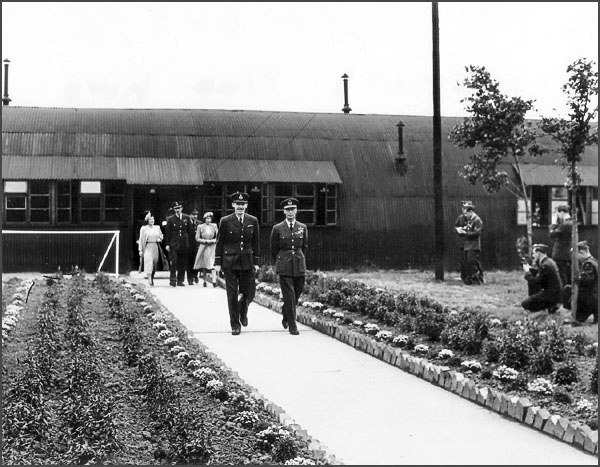 |
|
The photograph of the King and Queen shows Charles Appleton looking out a window on the right hand side of image. This was taken just after the crew had been presented to the King at RAF Leeming. |
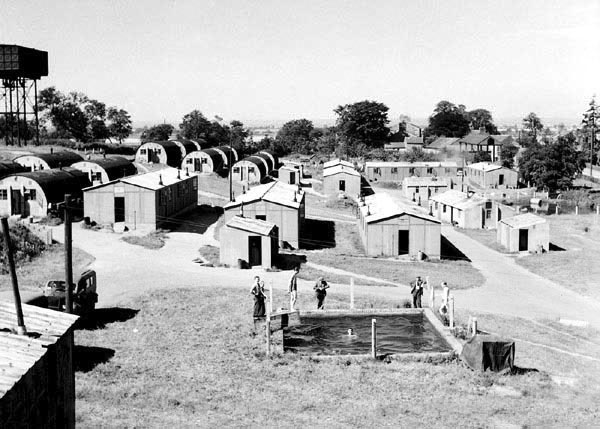 |
|
Some of the buildings on the airfield at Skipton-on-Swale. |
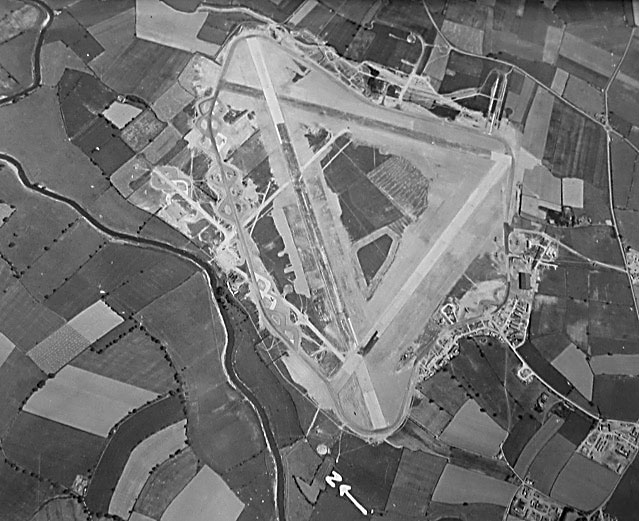 |
| Aerial photo of RAF Skipton-on-Swale |
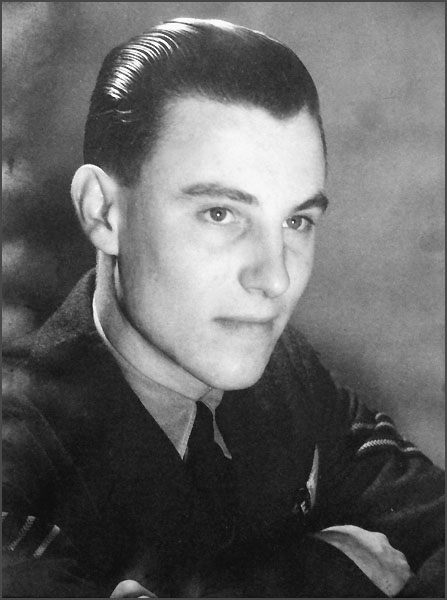 |
|
Terry Hobbs (father of Paul) taken in 1944. After 433 squadron he was promoted to Flt Lt and flew with No. 7 Squadron, pathfinders on Lancasters. After this tour he then went to No 49 squadron, again on Lancasters. |
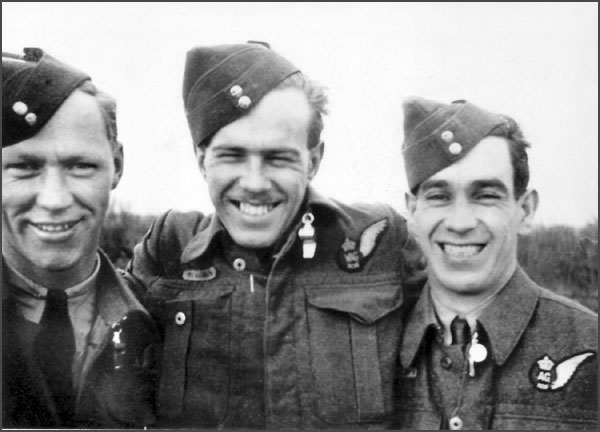 |
|
Roland Wallace (Rear Gunner), Vic Swimmings (Radio Operator), and Harold Edwards (Mid Upper Gunner). |
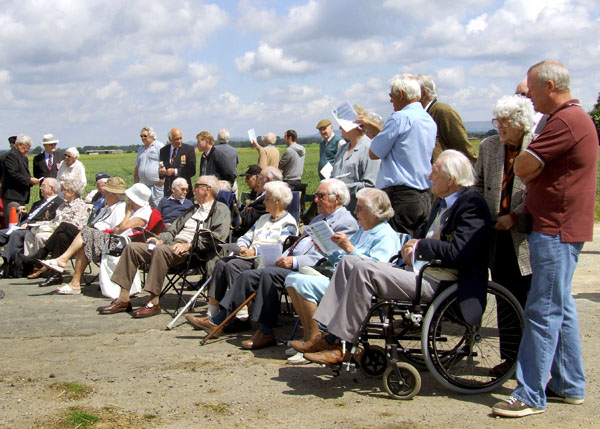 |
| Service of Remembrance 2009 |
| All photos are courtesy of Paul Hobbs who
provided the following: - "With the exception of Terry Hobbs, the Flight Engineer all the crew came from Canada - although Charles Appleton was born in Cambridgeshire England. Charles Appleton ( Pilot ), Murray Dobson ( Navigator), Vic Swimmings ( Radio Operator ), Roland Wallace ( Rear Gunner ), Harold Edwards (Mid Upper Gunner ) and the original Bomb Aimer Norm McEwen crewed up at OTU Wellesbourne Mountford near Warwick, Staffordshire and commenced flying Wellingtons. After OTU the crew spent two miserable weeks under the control of the British Army on a battle course at Dalton, then to 1659 Heavy Conversion Unit at Topcliffe Yorkshire. The crew were joined by a very young Flight Engineer Terry Hobbs who had originally trained for Stirlings while at St. Athens. Norm McEwen had to be replaced as B/A by Ernie Dickson on medical grounds. Thus the crew was formed and in early 1944 they were posted to Skipton-on-Swale North Yorkshire, which was to be their new 'home' for the next six months and 32 operations the majority flown in Beer Is Best. Beer Is Best is believed to have done the greatest number of operations of any 6 Group Halifax, 97 in total. It was scrapped in 1947." |
[Aircraft & Markings | Commanding Officers]
|
|
Formed at Tholthorpe on 13 June 1943 as a bomber unit within No 6 (RCAF) Group, it was the penultimate Canadian bomber unit to be formed in Britain. It received Halifax Vs from the start, and it carried out its first operation, a raid on Milan, on the night of 12/13 August 1943. In December 1943 it moved to Croft, where it received some Halifax IIIs in May 1944, although it continued to operate both models until December 1944 when Lancasters arrived. Its last bombing mission took place on 25 April 1945, when along with other 6 Group units, it attacked gun emplacements on the island of Wangerooge. The squadron then began to convey POWs back from Europe but in June, it returned to Canada, where it disbanded on 5 September 1945. Motto: In excelsis vincimus (We conquer in the heights) |
| Battle Honours |
| English Channel; North Sea 1943-1944; Baltic 1943-1944; Fortress Europe 1943-1944; France and Germany 1944-1945; Biscay Ports 1944; Ruhr 1943-1945; Berlin 1943-1944; German Ports 1944-1945; Normandy 1944; The Rhine |
Squadron Codes used: -
| WL | Jun 1943 - Sep 1945 |
|
|
|
|
|
Bill Kirkpatrick's crew on No 434 Squadron, 1945 Photo - Bill Kirkpatrick (via R Adams) |
[Aircraft & Markings | Commanding Officers]
http://www.rcaf434squadron.com/
|
|
This squadron was formally formed on 20 August 1944 at Gujarat in India, but it was October before any ground personnel arrived. Its aircraft also began to arrive in October in the form of Dakotas and it began to work up. Operations began in December from its new base at Tulhali and these mainly consisted of supply dropping missions to the troops of the 14th Army, often into very small jungle clearing or cuttings. In January, following attacks by Japanese fighters and the loss of two aircraft, the squadron moved over to night drops temporarily. Operations continued apace into 1945 with the squadron moving to Sentinel Hill in March and by June it was conducting famine relief by delivering rice to North Burma. However, in August the squadron moved to the UK and reformed at Down Ampney as part of No 120 (RCAF) Wing in Transport Command. It now ran scheduled services to the continent using Croydon as its normal terminal, although its home base remained Down Ampney, where it disbanded on 1 April 1946. Motto: Certi provehendi (Determined on delivery) |
| Battle Honours |
| Burma 1944 - 1945 |
Squadron Codes used: -
| - | Only Transport Command call sign carried |
[Aircraft & Markings | Commanding Officers]
|
|
This squadron was formally formed on 20 August 1944 at Gujarat in India, but it was October before any ground personnel arrived. Its aircraft began to arrive in November in the form of Dakotas and it began to work up. Its first operation in December was to move No 117 Squadron from Bikram to Hathazari. In January it performed similar duties for No 42 Squadron and then began ferrying supplies to XXXIII Corps. It continued to operate throughout the area until the end of the war and despite the repatriation of personnel it began casualty evacuation sorties to Chittagong and even Hong Kong. At the end of August 1945 tits routes were handed over to No 48 Squadron and it returned to the UK, where it reformed at Down Ampney on 26 September as part of No 120 (RCAF) Wing in transport Command. It was now ferrying freight throughout Europe and carrying out trooping flights to Norway Germany and Czechoslovakia. From April 1946 the squadron moved to Odiham, where it finally disbanded on 22 June 1946. Motto: Onus portamus (We carry the load) |
| Battle Honours |
| Burma 1944 - 1945 |
Squadron Codes used: -
| U6 | Allocated but not used |
| - | Only Transport Command call sign carried |
[Aircraft & Markings | Commanding Officers]
|
|
Formed at Blakehill Farm on 4 September 1944, it was equipped with Dakotas in the airborne forces role. Its first operation was Operation Market Garden, the airborne assault on the Rhine bridges. 14 of its aircraft towed gliders into Arnhem on 17 September and a further six followed the next day. It then settled into flying routine shuttle services onto the continent as well as continuing re-supply mission into Arnhem. Ansons joined the squadron in November and it maintained its shuttle services until March 1945, when the squadron began training for Operation Varsity, the crossing of the Rhine, which took place on 24 March. Having towed 24 Horsa gliders during the crossing the squadron returned to its normal routine. With the end of the war the squadron began the repatriation of POWs and Canadian troops to the UK. In November 1945, the squadron joined No 120 (RCAF) Wing of Transport Command flying regular schedules to the continent using Croydon as an advanced base. The squadron disbanded at Odiham, to where it had moved in November 1945, on 16 June 1946. Motto: Omnia passim (Anything Anywhere) |
| Battle Honours |
| France and Germany 1944-1945 Arnhem, Rhine |
Squadron Codes used: -
| Z2 | Sep 1944 - Jun 1946 |
[Aircraft & Markings | Commanding Officers]
|
|
Originally formed as No 18 Squadron RCAF in 1932 as bomber unit, it was re-numbered 118 in 1937. In 1939 was re-classified as a Coastal Artillery Co-operation unit and in 1940 as a fighter squadron. Initially serving on the East Coast of Canada it moved to Alaska in June 1942 and in October 1943 was selected to move to the UK, where it arrived on 15 November being redesignated No 438 on the same day. Its first base was Digby and it was here it received its Hurricane IVs andbegan working up in the fighter-bomber role. On 10 January 1944 it joined No 143 Airfield (later No 143 Wing) at Ayr and began to receive its operational equipment, the Typhoon. During the build up to D-Day it carried out attacks against V-1 sites, radar installations and lines of communications and during the invasion itself, the unit operated in the 'cab-rank' role. At the end of June it moved onto the continent from where it was better positioned to provide direct air support to the advancing Allied armies. The squadron settled in Germany in April 1945 and remained there until 26 August, when it disbanded at Flensburg. Motto: Going Down |
| Battle Honours |
| Fortress Europe 1944, France and Germany 1944-45, Normandy 1944 Arnhem, Rhine |
Squadron Codes used: -
| F3 | Nov 1943 - Aug 1945 |
[Aircraft & Markings | Commanding Officers]
|
|
Originally formed as No 123 Squadron RCAF in October 1941, it was selected for service overseas in 1943 and arrived in the UK on 1 January 1944 , where it was re-numbered as No 439 Squadron.It worked up on Hurricane IVs but the following month received its operational equipment in the form of Typhoons. On 10 January it joined No 143 Airfield (later No 143 Wing) at Ayr and began operations in March. Together with No's 438 and 440 Squadrons it operated during the build up to D-Day by carried out attacks against V-1 sites, radar installations and lines of communications and during the invasion itself, the unit operated in the 'cab-rank' role. On 27 June it moved onto the continent from where it was better positioned to provide direct air support to the advancing Allied armies. The squadron settled in Germany in April 1945 and remained there until 26 August, when it disbanded at Flensburg. Motto: Fangs of death |
| Battle Honours |
| Fortress Europe 1944, France and Germany 1944-45, Normandy 1944 Arnhem, Rhine |
Squadron Codes used: -
| 5V | Jan 1944 - Aug 1945 |
[Aircraft & Markings | Commanding Officers]
No 440 (City of Ottawa and Beaver) Squadron
|
|
Originally formed as No 111 Squadron RCAF, equipped with Kittyhawks it was selected for overseas service in October 1943, it arrived in Britain and was redesignated No 440 Squadron on 1 February 1944. It was immediately posted to Ayr where it joined No's 438 and 439 to make up No 143 Airfield (later No 143 Wing). It worked up on Hurricane IVs but the following month received its operational equipment in the form of Typhoons. Together with No's 438 and 439 Squadrons it operated during the build up to D-Day by carried out attacks against V-1 sites, radar installations and lines of communications and during the invasion itself, the unit operated in the 'cab-rank' role. On 27 June it moved onto the continent from where it was better positioned to provide direct air support to the advancing Allied armies. The squadron settled in Germany in April 1945 and remained there until 26 August, when it disbanded at Flensburg. Motto: Ka ganawaitak saguenay (He who protects the Saguenay ) |
| Battle Honours |
| Fortress Europe 1944, France and Germany 1944-45, Normandy 1944, Arnhem, Rhine, Aleutians 1942-43 |
Squadron Codes used: -
| I8 | Feb 1944 - Aug 1945 |
[Aircraft & Markings | Commanding Officers]
 |
Originally formed as No 125 Squadron RCAF as a fighter unit in 1942, it operated along the East Coast of Canada until late 1943, when it was selected for overseas service. Arriving in Britain on 8 February 1944, it was redesignated No 441 Squadron at Digby. Together with its fellow Canadian units, No's 442 and 443 Squadrons, It became part of No 144 Airfield (later No 144 Wing). Working up on Spitfire Vs, the squadron received Spitfire IXs the following month and became operational. From then until the invasion in June the squadron carried out deep penetration missions using 90 gallon drop tanks. During the landings themselves, the squadron provided low level fighter cover and on 15 June it moved onto the continent. However, in September the need for fighter squadrons in France was reduced following the Allied breakthrough and the squadron was recalled to Britain from where it flew mainly bomber escort operations until December when it moved to Scotland for the defence of Scapa Flow. In April 1945 the squadron returned south to Hawkinge but at the end of the month returned to Digby where it began converting to Mustangs. Moving to Molesworth in July, it disbanded there on 7 August 1945. Badge ** Motto: Stalk and kill |
| Battle Honours |
| Defence of Britain 1945, Fortress Europe 1944, Normandy France and Germany 1944-45, Arnhem Walcheren |
Squadron Codes used: -
| 9G | Feb 1944 - Aug 1945 |
[Aircraft & Markings | Commanding Officers]
|
|
Originally formed as No 14 Squadron RCAF as a fighter unit in January 1942, it operated along the West Coast of Canada until late 1943, when it was selected for overseas service. Arriving in Britain on 8 February 1944, it was redesignated No 442 Squadron at Digby. Together with its fellow Canadian units, No's 441 and 443 Squadrons, It became part of No 144 Airfield (later No 144 Wing). Working up on Spitfire Vs, the squadron received Spitfire IXs the following month and became operational. From then until the invasion in June the squadron carried out deep penetration missions using 90 gallon drop tanks. During the landings themselves, the squadron provided low level fighter cover and on 15 June it moved onto the continent. It was now heavily involved in ground attack sorties and continued to move forward in order to maintain its close air support of the ground forces. Having avoided being caught on the ground during the Luftwaffe's New Years attack on Allied airfields, it claimed 24 enemy aircraft destroyed during the attack. However, in March 1945 the squadron returned to the UK, without its aircraft, for leave and on re-assembling at Hunsdon in April, it began conversion to Mustangs. These were used to fly long range escort missions to Bomber Command Lancasters and lasted a month flying ceased in May. The squadron disbanded on 7 August 1945 at Molesworth. Motto: Un dieu, une reine, un coeur (One God, One Queen, One Heart) |
| Battle Honours |
| Fortress Europe 1944, France and Germany 1944-45, Normandy 1944, Arnhem, Rhine |
Squadron Codes used: -
| Y2 | Feb 1944 - Aug 1945 |
[Aircraft & Markings | Commanding Officers]
|
|
Originally formed as No 127 Squadron RCAF as a fighter unit in July 1942, it operated along the East Coast of Canada until late 1943, when it was selected for overseas service. Arriving in Britain on 8 February 1944, it was redesignated No 443 Squadron at Bournemouth and was soon based at Digby, together with No's 441 and 442 Squadrons. Working up on Spitfire Vs, the squadron received Spitfire IXs the following month and became operational. From then until the invasion in June the squadron carried out deep penetration missions using 90 gallon drop tanks. During the landings themselves, the squadron provided low level fighter cover and on 15 June it moved onto the continent. It was now heavily involved in ground attack sorties and continued to move forward in order to maintain its close air support of the ground forces. Having returned to Warmwell for an air-firing course the squadron missed the Luftwaffe's New Years attack on Allied airfields. Unlike its two fellow squadrons, it did not return to Britain, but stayed on the continent, following the Allied armies advance into Germany. With the end of the war the squadron joined the British Air Forces of Occupation until disbanding at Utersen on 15 March 1946. Motto: Our sting is death |
| Battle Honours |
| Fortress Europe 1944, France and Germany 1944-45, Normandy 1944 Arnhem, Rhine |
Squadron Codes used: -
| 2I | Feb 1944 - Mar 1946 |
[Aircraft & Markings | Commanding Officers]
Badges marked ** on this page are have been produced by Mary Denton on behalf of the RAF Heraldry Trust and are displayed on this page with the permission of the RAFHT. Mary Denton and the RAFHT have probably completed half of the 'official' badges authorised but are still looking for sponsorship for the remaining badges. The work continues and details can be found on their website.
This page was last updated on 17/03/25©
![]() Organisational Index
Organisational Index ![]()